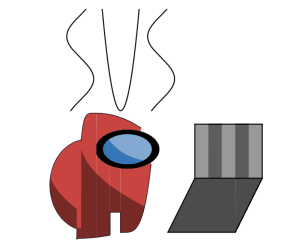This will likely be my last Edublog post. Thanks for joining me on this journey. G23 Signing off!
Author: Kenya
Red Dress Day Reflection

For Red Dress Day, I designed this pin. Red Dress Day is an annual day of mourning for the Missing and Murdered Indigenous Women and Children. Schools and communites are urged to participate in different ways, the most common symbol being red dresses hung from trees. These dresses and shadows represent the women who otherwise should have been alive still. This day of mourning is part of what we must do in order for true Truth and Reconciliation, having a day of awareness educates non-Indigenous communites. For this years Red Dress Day, May 5th, 2023, I was away for the drum circle, although I was able to make pins beforehand and wear it for the time that I was at school. It is significant that all nationalities to show up for this day, as it is important for the world to unite and lift up the voices of minorities and struggling groups, and advocate for the safety of all.
Defining Acids & Bases Lab CC
Calculus 12 Rollercoaster – The DeathCoaster




EFP12 Podcast

This is my group’s podcast that follows our essential question; How do indigenous authors portray the ongoing struggles of indigenous peoples today in literature?
A&P 12 Core Competency Reflection
Desmos Art Functions Card 2022

https://www.desmos.com/calculator/e6ktqpiq03
Reflection: When making my design, I knew what equations to use based off of what shape I was looking for, and I could change them if a different function was a better fit. I had a challenge finding an image that was reasonable to work with given the time. I also had a struggle shading a part of the body because another shade wouldnt let me overlap it due to the opacity, but I realized it wasn’t worth the time trying to fight it. I didn’t have any extreme moments of joy in this project, no aha-moments. I did not get any help for this project, I worked entirely on my own and created everything from start to finish. A strategy I used was recalling previous projects and remembering what shapes work well for certain images, as well as knowing how to shade. I didn’t need to make a custom colour because I know how to mix colours, so for example I just put a bit of black over the red to shade the body. I was able to squeeze a sin function in, which is new to all of us this year. I also was able to use transformations for certain repeating shapes instead of making more functions, as I would have in previous years. All in all, I know the image is silly, and it certaintly wouldnt’ve been my first choice, but it was quite easy to shade.
Midterm Self Evaluation
 Loading...
Loading...
Protein Synthesis
In Anatomy & Physiology 12, we recently learned about protein synthesis and related ideas. We modeled a 3D version using paper and markers.
There are two main steps in protein synthesis: transcription and translation, and I will be exploring both below.
Transcription consists of three steps: unwinding/unzipping, complementary base pairing, and separation from DNA. Unwinding/Unzipping is the first step that involves the undoing of the double helix shape using DNA helicase, this leaves two strands for mRNA to attach to and start reading. Complementary base pairing is done after the initial reading of DNA. mRNA then pairs nucleotides with its pairing in order to transcribe the message on that particular strand. A photo from our complementary base pairing is below. Lastly, there is the separation from DNA as the mRNA needs to deliver the recently transcribed message to the ribosome.

Translation also consists of three steps: initiation, elongation, and termination. Initiation is when mRNA binds to a small ribosome subunit as two ribosome subunits bind together, thus initiating translation. Elongation is the adding of translated amino acids in the correct order that they are found, this continues until termination. A photo from this process is below. Termination is a simple step, when a STOP codon is read, the chain of amino acids is released. The polypeptide you are left with is now a protein.

Using a 3D model (such as the one above) is an effective way to visually understand both processes. In some ways the model was accurate, such as having correctly paired bases and such, although things became misrepresented as 1) there was no knowledge or understanding of mutations from this model and 2) it was difficult to set up the correct sides as 3′ and 5′. It got tricky as if you made a minor mistake in the beginning, your outcome would be effected greatly. Our group also was a day behind, so our understanding was lacking. Having a visual model did help regain our understanding, though. In order to better understand the process, I would recommend that we have the correct amount of materials needed as well as understanding the molecules and functions behind them. We felt that the amount of information was overwhelming due to the time given, although with collaboration, we were able to put some things together.
I believe that models are very much effective in teaching the public about scientific findings. Models give for an opporunity to visually understanding and conceptualize an idea, as well as opportunities for self-lead learning and collaboration. Although sometimes models can leave information out, or come off confusing if not done correctly.